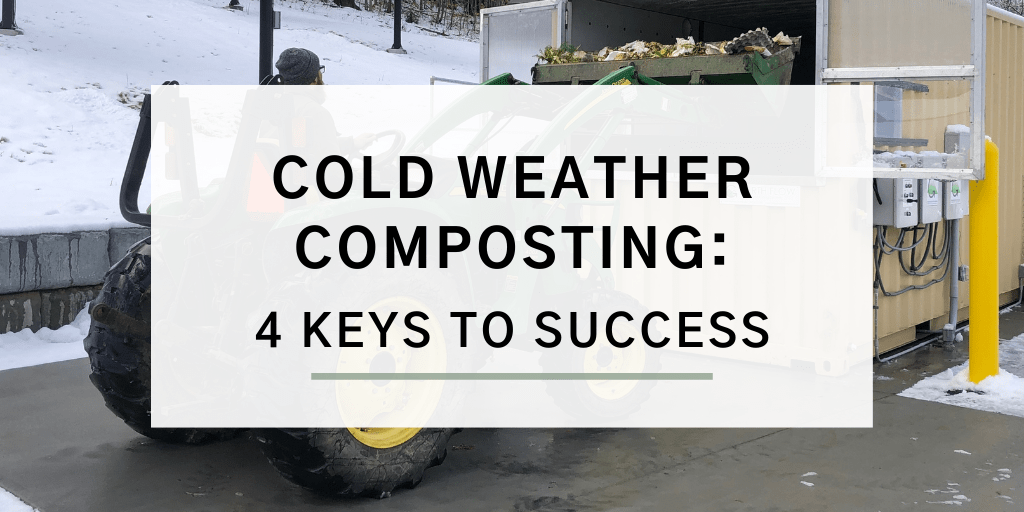
Thermophilic microbes living in a hot compost pile thrive at temperatures in the realm of 120 to 140 degrees Fahrenheit. These hot temperatures produce the highest diversity of microbes and are the most productive at composting. However, cold weather can threaten those desired composting temperatures. Without careful planning and design, the compost can freeze, which can spell the end of composting until warm weather returns. If one wants to compost year-round, it’s helpful to understand how to manage the composting process in freezing weather. While this might seem difficult or impossible, it’s actually quite doable (if you understand what the microbes need). Let’s explore some ways to make cold weather composting a success.
#1. Recipe
A balanced compost recipe is critical to effective cold weather composting. The colder the temperature outside, the more precise the recipe must be. In other words, if the microbes don’t have what they need in terms of food, air, water, and living conditions, they don’t stand a chance.

Earth Flow Custom Vessel composting at Gustavus Adolphus College in St. Peter, Minnesota 
Earth Cube composting in Cook City, Montana
While the intricacies of building effective compost recipes is beyond the scope of today’s topic, here is one key tip for ensuring a good compost recipe in cold weather: keep your carbon dry. In winter weather, carbon sources, such as leaves and wood chips, tend to get wet from rain and snow. This tends to result in overly saturated compost, especially for food waste composting. To make matters worse, when the temperatures drop, that moisture can cause the pile of leaves or pile of wood chips to freeze and be unusable. In order to maintain a good moisture balance in a compost pile, keep that carbon source dry.
#2. Insulation
Assuming one has created an appropriate compost recipe, insulation is another important tool for protecting a compost process in cold weather. While compost itself is a good insulator, if the exterior of the compost pile is exposed to freezing temperatures, this increases the risk of the compost temperatures crashing in severe freezing conditions. The more the compost pile is insulated from the freezing weather, the easier it is for the microbes to maintain their internal compost temperatures. Protection from freezing winds, snow, and rain can all be beneficial to protecting the compost environment. This points to in-vessel composting systems, where it is relatively easy to insulate a vessel and protect a compost pile from severe weather. For instance, our Earth Flow and Earth Cube systems offer options for vessel insulation for cold weather
#3. Freeze Protection
Sometimes even a proper recipe and insulation can’t stand a chance against the cold. This is particularly the case for smaller composting masses that have less capacity for heat retention. Also, if outside temperatures drop well below freezing (say -10 to -50 degrees Fahrenheit), it becomes difficult for the compost to maintain its internal temperatures; simply too much heat is being pulled away.

In these situations, an external heat source may be necessary to keep the compost from freezing. This could be an electrical heater integrated into the floor of the vessel or the entire compost vessel might be located inside a building with minimal heating to prevent freezing and protect from wind. The best solution depends on a variety of factors and needs for the compost process.
#4. Start Up
Starting a compost pile in cold weather is a particular challenge. It’s a bit like starting a fire in cold, wet weather. It’s hard to get the fire started but it’s relatively easy to keep it going. A hot compost process is similar. If you can start the compost pile before the weather gets cold and it’s much easier to keep it going once the cold arrives. One suggestion is to begin your compost process in warm weather. That way, when the cold weather arrives, the compost is already hot and thriving. Also, the larger the compost pile the more capacity it has for maintaining its internal heat. So larger compost piles are easier to keep at the desired temperature.
If you need to start your compost pile in below freezing weather, one trick is to blend a small batch of compost feedstock indoors and then bring that small batch outdoors once the compost temperatures have started to rise. Then add plenty of cover material over the pile to protect that cooking compost from the cold weather.
By carefully monitoring your piles and integrating these heat-positive conditions, your compost will be armed and ready for any weather. If winter weather is making year-round composting a challenge for you, we can help! Contact us today.

